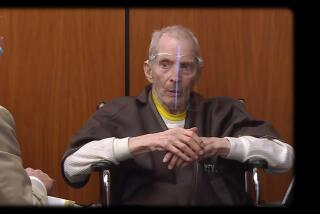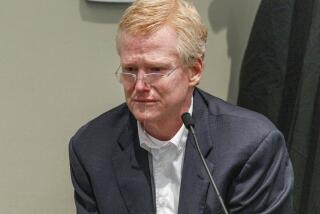Millionaire Acquitted of Murder
- Share via
GALVESTON, Texas — A jury on Tuesday found New York real estate heir Robert Durst not guilty of murder, despite his admission that he dismembered his neighbor’s corpse and threw the remains into the sea.
The decision by the eight-woman, four-man jury came after five days of deliberation, sending gasps through the courtroom in this beach town south of Houston where Durst had moved three years ago -- disguising himself as a mute woman.
As Texas District Judge Susan Criss announced the verdict, the 60-year-old defendant stood stunned, his mouth agape, his eyes welling with tears. After several deep breaths, Durst embraced his high-profile, high-priced defense team and grinned.
His legal tangles, however, are not over. Durst remains in custody here on bail-jumping charges, and is a key figure in two other police investigations.
But legal analysts said Durst appeared to have benefited from a combination of a talented defense team, a lack of physical evidence and a series of rulings during the murder trial that were barely noticed at the time, but which may have made the difference in the end.
Had he been convicted, Durst was looking at a prison term of up to 99 years.
The verdict came after six weeks of grisly testimony in a case that was both a local curiosity and high-society spectacle. In Galveston, laid-back beachcombers and retirees wandered in off the street to watch the trial unfold. And in New York, where Durst’s grandfather had launched a real estate empire a century ago -- supposedly after arriving in the United States with just $3 sewn into the lapel of his jacket -- the case was watched for every lurid detail.
A forest of television-truck antennas sprouted up at times, New York tabloids camped out throughout the trial, and some Internet newsletters that typically focus on hot properties followed the case closely, providing Realtors with daily trial updates.
Interest in the case climaxed with the four days that Durst himself spent on the witness stand, describing his bulimic childhood, moving into his hatred of the real estate business and offering a number of bizarre asides, including a detailed allocution on the difficulties of jogging in a wig.
After the verdict, defense lawyer Dick DeGuerin credited jurors for looking past the dismemberment and focusing on the crime Durst was charged with: intentionally killing 71-year-old Morris Black.
“We all know that the worst part about this case is what Bob did after Morris Black was dead. He dismembered the body, then fled,” DeGuerin said. “But the jury looked at this case for what the charge was and was not unduly influenced by the horrible things that happened after Morris Black died.”
Galveston County Dist. Atty. Kurt Sistrunk said he was dismayed by the verdict. Asked whether Durst was a threat to the community, Sistrunk said: “Mr. Durst is not going to be invited to my house.”
Jurors said they agreed with that assessment of Durst’s character. Indeed, they said, they had discounted virtually everything he told them from the witness stand -- forcing them, they said, to devise their own timeline of events leading to Black’s death, which they taped to the wall of the deliberation room.
Durst had acknowledged all along that he was there when Black was shot in the face, but he asserted that the gun went off accidentally while he was defending himself against his enraged neighbor. Several jurors said Tuesday that the prosecution simply did not have enough evidence to prove otherwise.
“It comes down to reasonable doubt,” said juror Joanne Gongora, 49, a nursing instructor. “The burden is on the prosecution to show how the event happened, and we didn’t see that. It wasn’t proven.”
On the witness stand, Durst explained that he had moved to Galveston in November 2000 after prosecutors in New York reopened an investigation into the 1982 disappearance of his first wife. He disguised himself, he said, largely to escape the scrutiny of the media in New York.
Durst told the jury that on Sept. 28, 2001, he and Black, a cantankerous friend who lived across the hall in a low-rent apartment building, fought over a gun. During the struggle, the weapon accidentally fired, Durst said. Panicked and fearful that police would not believe the word of a cross-dressing millionaire, Durst said, he downed a bottle of Jack Daniel’s whiskey, severed Black’s limbs with a bow saw, stuffed them into garbage bags and threw the remains into Galveston Bay.
Then he tried to cover up other evidence of Black’s death.
Prosecutors argued repeatedly during the trial that Durst’s actions did not paint a portrait of an innocent man.
“They tried to make the case that anytime you can show flight or an attempt to hide evidence of someone being killed, there is an implication that the person must know he is guilty,” said Sandra Guerra Thompson, a professor at the University of Houston law center and director of the school’s criminal justice institute.
“If he didn’t think he was guilty, a reasonable person would not act this way. That is very common logic that is used in criminal cases. But it didn’t work in this case,” Thompson said.
Both Durst’s attorneys and prosecutors had declined to present the jury with the option of convicting him on a lesser charge, such as manslaughter. In most cases, jurors cannot seek those charges on their own.
It was an all-or-nothing gambit. But given the state’s lack of evidence that Durst intended to kill Black, a critical threshold to win a murder conviction, it was a defense-smart strategy, said John Jay Douglass, a professor at the University of Houston law center and the former dean of the National College of District Attorneys.
“The public thought this was a clear-cut case, but it wasn’t, and the defense knew it,” Douglass said. “There were only two witnesses to what happened, and one of them is dead.”
Durst’s attorneys, in open court, also convinced the judge that jurors should not be allowed to review a notebook found in the car Durst was driving in November 2001 when he was arrested in Black’s death. They argued that the notebook was personal writing and could not be used as evidence against him.
Among the items in the notebook was the workplace address of a Connecticut woman who has fought for two decades to keep the investigation into Durst’s first wife’s disappearance alive. The woman has been outspoken about her belief that Durst played a role in the disappearance, although he has denied it.
Another page in the notebook contained a list of aliases Durst used during the months following Black’s death.
Prosecutors said their case also suffered because all of Black’s body parts washed ashore except for his head, which contained the bullet; that has never been found.
“I think the main thing [the jury] wanted was the head,” said Joel Bennett, Galveston County assistant district attorney, who met with jurors privately after the verdict to discuss the case.
Durst also had cleaned his apartment so well that prosecutors were left only a few specks of blood, said juror Deborah Warren, a surgical technician who works in the labor and delivery room at a local hospital.
“The prosecutors did the best that they could with what they had. We did the best that we could with what we had,” Warren said. “My stomach is still knotted up.”
In Texas, a court date has not yet been set on a bail-jumping charge against Durst, who fled Galveston after Black’s death. Durst was a fugitive for six weeks until he was caught in Pennsylvania after police alleged he tried to shoplift a $5 hoagie and a box of bandages, even though he had $500 in his pocket and had left Galveston, according to his own testimony, with $500,000 in cash.
In Westchester County, N.Y., Dist. Atty. Jeanine Pirro has reopened the case into the disappearance of Durst’s first wife, Kathleen. Durst has not been charged in that case, and has alleged that he is the victim of Pirro’s political ambition.
“The Texas jury has spoken,” Pirro’s office said Tuesday in a prepared statement. “We accept the verdict. But it does not affect the investigation into the disappearance of Kathy Durst.”
In California, the Los Angeles Police Department has said that Durst is a “person of interest” in the Christmas Eve 2000 shooting death of his close friend, writer Susan Berman, who was about to be questioned in the disappearance of Kathleen Durst. Police Lt. Don Hartwell said Tuesday that the investigation was ongoing.
Hart reported from Galveston and Gold from Houston. Times staff writer Richard Winton in Los Angeles contributed to this report.
More to Read
Sign up for Essential California
The most important California stories and recommendations in your inbox every morning.
You may occasionally receive promotional content from the Los Angeles Times.











